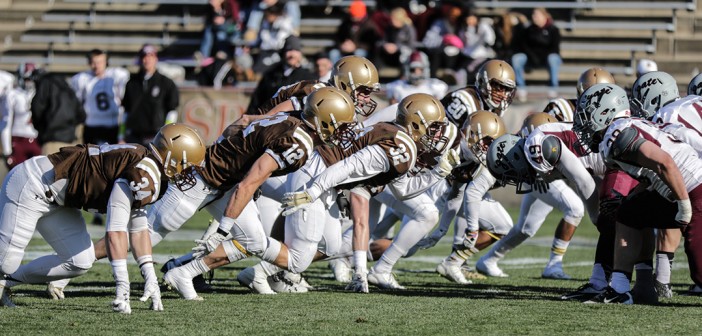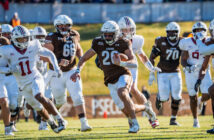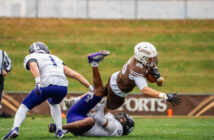The Mountain Hawks’ football squad has completed one of its more taxing seasons in recent history with a 3-8 record. It is a team in transition, having devoted much of its season to giving younger players a chance to succeed.
With a team in transition, it only makes sense that Lehigh’s entire football program, along with those of its Patriot League competitors, is in a time of transition, as well.
The reason for this is that in 2010, the league voted to allow scholar-athlete aid for reasons other than need-based financial aid support.
The changes mean that each school currently has two classes of players (current freshmen and sophomores) who have been awarded aid on the basis of being a part of the football program. Fordham University, which has been awarding aid to its athletes for a longer period of time, and Georgetown University, which has never offered scholarships, are the only two exceptions.
Over the past two seasons, the Rams of Fordham have been exceptional on the field, with just two regular season losses against FCS opponents. This year’s team won the Patriot League by going undefeated and started 18 seniors, compared to just four for Lehigh.
“They felt they needed to do this in order to attract the guys they needed to attract at Fordham,” said Joe Sterrett, Lehigh’s dean of athletics. “And so they started this program for more flexible aid for football five years ago. Every one of their classes is there on the basis of more flexible financial aid. They are at least two classes ahead.”
The Rams took a risk, since not abiding by Patriot League rules made them ineligible for the Patriot League title in football up until 2013. Now, the rest of the league is playing catch-up.
Another factor that contributed to the implementation of this new aid process was the presence of Army and Navy. Army and Navy are Patriot League members for all sports besides football, but their policy is drastically different. Army and Navy actually pay their athletes to attend. Their membership changed the perception of the league, making it more viable to make the change in football.
To begin the process, each Patriot League school was allowed 30 total equivalencies for the first two years of the program. Lehigh used 14.5 in the first year and the remaining 15.5 in the next year. Beginning with the fall 2013 freshman class, each Patriot League school is allowed to grant 60 equivalencies at any one time, according to the Patriot League operational bylaws. This means there are 60 total spots in any one year for players to be aided in cost of tuition; room and board; and supplies related to classes. However, equivalencies can be either full or partial in any fraction amount, so more than 60 players can benefit from aid.
It can be a challenge to try to find worthy players. With merit-based rewards being more readily given, there could be many more players who are attracted to the Patriot League. However, the league has features — particularly its high academic standards — that limit the number of feasible prospects year in and year out.
“Look at the number of academically talented players who are of the athletic capability of playing at this level, and then narrow that even more to particular positional needs,” Sterrett said. “Your national pool can be incredibly small.”
Indeed, the changes could play a part in increasing this pool, as academically strong high school football stars who may not necessarily have a high financial need now have the Patriot League as a more attractive option.
Lehigh’s football coach Andy Coen is feeling the positive effects of this change, as his recruiting efforts may now become more extensive on a national scale.
“The change in the process has been a positive,” Coen said. “We now have the ability to recruit more nationally and also are not limited, as we were before, with aid being awarded strictly by need.”
One factor that made many schools hesitant at first was that the policy could lower the historically very high academic standards for players entering the football program. However, Lehigh’s Assistant Director of Athletics and Recruitment Manager Chris Wakely is among those who would argue that the opposite is actually true.
“The academic performance of these individuals while they’re here is no different and, in many cases, is stronger than the overall student population as far as their academic performance,” Wakely said.
Another factor holding the process up was concern that it would increase spending to higher levels. However, Sterrett assures that the spending has not increased as a result of the changes to the football program, but instead is just distributed differently.
But with a total of 60, properly allocating the money based on needs is a complicated puzzle.
“Nobody wants to overpay for anyone,” Wakely said. “But the marketplace drives a lot of decisions, and it drives a lot of difficult decisions because the marketplace might say this individual is receiving these awards from all of these other institutions, but our coaches can say, ‘Based what our priority needs are for this particular recruiting class, we are not willing to go there for that kid.’”
The change definitely has the potential to make Lehigh’s football program stronger, but the question of when this will be noticed is tough to answer. While the Hawks are currently starting many promising young players who are here because of new scholarship capabilities, it remains to be seen how they, as well as others in classes that have not yet arrived, develop.
“With football more so than other sports, it takes time to grow up physically, to be effective on the football field,” Wakely said. “So those two classes (of current freshmen and sophomores) will take time to mature athletically and physically.”
Sterrett echoed the same sentiment as Wakely on the issue.
“Whether we are able to do that are not, whether those individuals are as good as advertised, whether they stay healthy, and whether they mesh with the other players on the team to produce, those are all variables that you cannot link directly to the availability of financial aid,” Sterrett said.
If anything, the biggest guarantee is that the Patriot League will gain a higher profile.
“I believe the reputation of our league will only grow as we all have scholarships,” Coen said. “The academic reputation is outstanding, and that won’t change. The reputation of the league as a football conference will grow due to scholarships.”






Comment policy
Comments posted to The Brown and White website are reviewed by a moderator before being approved. Incendiary speech or harassing language, including comments targeted at individuals, may be deemed unacceptable and not published. Spam and other soliciting will also be declined.
The Brown and White also reserves the right to not publish entirely anonymous comments.